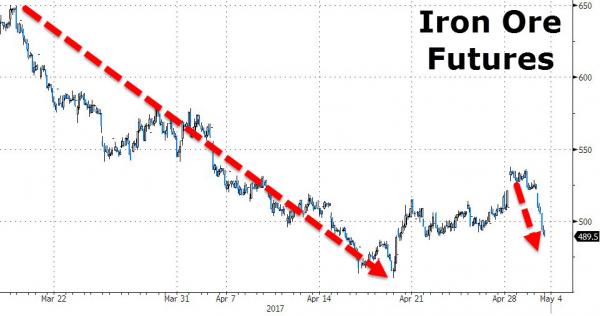S&P futures rose on hopes a successful Republican healthcare vote on Thursday will unlock the Trump fiscal agenda, while European shares jumped to a 20 month high on signs Macron is poised to win Sunday’s French election coupled with reassuring corporate results, including strong earnings from HSBC, even as Chinese and Australian stocks fell as commodities, and iron ore futures particularly, tumbled. Oil also declined while the Bloomberg Dollar spot index fell 0.1% in London morning trading, after gaining 0.4% Wednesday. It weakened against all but two of its Group of 10 peers.
As reported overnight, Iron ore traded in China plunged limit down (-8%) in the afternoon session, with Rubber also limit down (7% lower), and steel rebar, coke, coking coal tumbling over 6% on concerns a crackdown on Wealth Management Products and shadow banking in general – in addition to the worst service sector PMI print in nearly a year – could result in a hard-landing for the Chinese economy (something both PIMCO and Kyle Bass warned about in the past 24 hours). Of note: the drop in iron ore prices was the biggest so far this year.

Concerns about a crackdown of credit in China also dragged 10-yr treasury futures lower, down 0.44% at the close, while the 21st Century Business Herald reported that Chinese borrowing costs in April surged with the average coupon rate up near 200bp.
Chinese worries however were lost on Europe, if only for the time being, after Europe reported a stronger than expected Service PMI print, rising to 56.4 from 56.0, beating expectations of 56.2, the 46th consecutive month of expansion and the highest reading since April 2011. Of note: Italy posted a nearly 10 year ago on its composite PMI category.

Helping European risk sentiment, a poll showing Macron had outperformed far-right candidate Marine Le Pen in a televised debate sent short-term French bond yields to their lowest in five months, with encouraging euro zone data also helping the mood.The most recent Oddschecker data showed that the market now gives Macron a 90% probability of victory.

Additionally, a flurry of stronger than expected earnings updates in Europe sent the STOXX 600 up 0.4% to its highest since August 2015, gaining for the day in a row, and included a smaller-than-feared fall in bank giant HSBC’s profits which sent its shares up more than 3%.The Stoxx Europe 600 and FTSE 100 also headed higher. Oil and gas stocks were also up 1.1 percent following robust updates from both Statoil and Royal Dutch Shell, which rose 3 percent and 2.3 percent respectively.
A rebounding European economy and a string of upbeat earnings are prompting firms from Morgan Stanley to Deutsche Asset Management to boost allocations to the region’s stocks. After trailing for most of last year, the Stoxx Europe 600 Index has outpaced the S&P 500 Index.
“There are a number of things playing out at the moment. Traditionally in May there is a strong dollar effect and that is adding to the pressure on the commodity bloc,” said Unicredit’s head of FX Strategy Vasileios Gkionakis. “In Europe it is slightly different. There is what is going on with the French election and we have been seeing some strong data.”
“We see more value in Europe versus the U.S.,†Deutsche Asset’s global head of research Phil Poole said in an interview with Bloomberg TV’s Mark Barton. The investment arm of Deutsche Bank AG increased allocation to Europe in its multi-asset portfolios from the lowest on record in the past quarter, Poole said. “Valuations are attractive, the European economy is growing. We feel there’s too much optimism priced into the Trump stimulus program.â€
In the US, S&P 500 futures climbed on hopes Obamacare will get repealed giving a fresh boost to the Trump fiscal agenda and as investors awaited earnings reports from companies including Kellogg and Chesapeake. Futures on the S&P 500 Index expiring in June climbed 0.3 percent ot 6.75 to 2.390 at 6:40 am in New York. The benchmark hasn’t posted gains or losses exceeding 0.2% for six straight sessions, and has struggled to top a record last seen on March 1. Contracts on the Dow Jones Industrial Average added 52 points to 20,931 on Thursday.
At the end of its two-day meeting, the Fed kept its benchmark interest rate steady, as expected, but downplayed weak first-quarter economic growth and emphasized the strength of the labor market, a sign it was still on track for two more rate increases this year. Futures traders are now pricing in a 72 percent chance of a June rate hike, from 63 percent before the Fed’s statement, according to the CME Group’s FedWatch Tool. Attention now turns to U.S. non-farm payrolls for March, due on Friday, after separate data showed private employers added 177,000 jobs in April. That was higher than expected but the smallest increase since October.
After the dollar had risen across the board after the Fed’s meeting on Wednesday, the dollar index which measures it against the top six world currencies, was modestly lower, erasing some gains. It was, however, well higher at 113.00 yen. The euro meanwhile drew some support from Macron’s performance ahead of Sunday’s election run-off, and was barely budged at $1.0876.
In commodities, oil fell for a third session in four to leave it near its lowest since late March at $50.50 after the China services wobble and supply data had shown a smaller than expected decline in U.S. inventories. Bellwether industrial metal copper was also teetering near a four month low on what traders said was China-based selling and on expectations that two U.S. rate rises this year could curb interest in dollar-denominated metals. Iron-ore futures slid 5.3 percent. Copper futures dropped 0.4 percent extending Wednesday’s worst tumble since 2015.Oil declined 0.7 percent to $47.46 a barrel.

